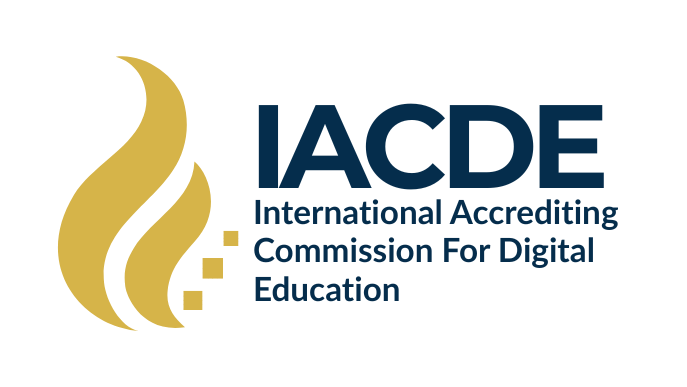Starting a new educational institution is both an act of vision and a test of endurance. Whether you are founding an online academy, faith-based university, or career training center, the journey begins with one crucial decision—to build on a foundation of purpose, structure, and excellence. At the International Accrediting Commission for Digital Education (IACDE), we work with new and emerging institutions around the world, helping them establish credibility and meet international quality standards. Here’s how to get your school off the ground the right way.
1. Start with a Clear Mission and Vision
Every successful school begins with a compelling mission. Before designing programs or registering your organization, clarify what problem your institution exists to solve. Are you preparing future leaders, empowering underserved learners, or providing faith-based or digital education? Your mission should capture your heart and your “why,” while your vision paints the future you want to create.
Once your mission is clear, draft your core values—principles that guide how your institution operates. These values will shape your academic culture, marketing voice, and even your accreditation narrative. Schools that begin with a strong mission have an easier time attracting aligned students, faculty, and partners.
2. Choose the Right Legal and Organizational Structure
Before you design a logo or course, your institution must exist legally. Registering your school protects your brand, allows you to open bank accounts, and prepares you for recognition and accreditation. Most founders choose between a for-profit model (LLC or Corporation) or a nonprofit or faith-based entity. The right choice depends on your purpose, funding model, and target audience.
If your goal is ministry-driven or community-based education, consider registering as a nonprofit or faith-based organization. For academies focused on professional or skills-based training, an LLC can provide flexibility and revenue control. Whichever path you choose, ensure you secure your Employer Identification Number (EIN), operating license, and any educational exemptions that apply in your state or country.
3. Build a Strong Digital Learning Environment
Today’s learners expect modern, accessible learning experiences. Selecting the right technology is one of the most important early decisions you’ll make. Choose a Learning Management System (LMS) that aligns with your goals, scale, and budget. Canvas, Moodle, Thinkific, or LearnPress are popular options that allow you to host courses, track student progress, and issue certificates.
Beyond the LMS, you’ll need a professional website that communicates trust and clarity. Your site should include your mission, academic programs, admissions information, and an application or inquiry form. Add a secure payment system for tuition and donations, and integrate clear communication tools such as email newsletters, Zoom, or Microsoft Teams. Together, these systems form the foundation of your digital campus.
4. Design a Curriculum that Aligns with Real-World Needs
Curriculum is the heartbeat of your institution. The most effective schools design courses around what learners will do after completing them—not just what they will know. Start by identifying key competencies and outcomes, then map your curriculum backward to ensure every course supports those outcomes.
To make your curriculum stand out, ensure it integrates real-world applications, ethical standards, and measurable objectives. Students should graduate with skills they can use immediately—whether that means launching a business, serving a community, or applying faith-based principles in their professional life. Curriculum that combines theory, reflection, and practice is what IACDE considers “AI-proof”—learning that cannot be replicated or replaced by automation.
5. Create Institutional Policies and Handbooks
Even a small school needs clear policies and documentation. Accreditation bodies and students alike look for transparency and consistency. Develop an Admissions Policy that defines your requirements, an Academic Integrity Policy that outlines expectations, and a Code of Conduct that reflects your mission and values. Faculty and Student Handbooks communicate professionalism and help prevent misunderstandings as your institution grows.
Policies are not just administrative documents—they communicate who you are. They tell your community that you value structure, accountability, and fairness. Having them in place also prepares you for candidacy and accreditation with IACDE or any other quality assurance organization.
6. Begin the Accreditation Process Early
Accreditation should not be the final step in your journey; it should guide you from the beginning. Through IACDE’s Candidacy and Accreditation Pathway, institutions receive step-by-step mentorship, document templates, and personalized feedback to ensure they meet quality benchmarks. Starting this process early allows you to grow with clarity and confidence rather than having to redesign your systems later.
During candidacy, your institution completes the Institutional Self-Assessment Report (ISAR™), a comprehensive self-study that examines your governance, programs, finances, and student outcomes. The process helps you strengthen internal systems, demonstrate accountability, and gain international recognition.
Accreditation also builds credibility with potential students, faculty, and partners. When learners see that your institution is recognized by IACDE, they know your programs meet global standards for excellence in digital education.
7. Build a Sustainable Marketing and Enrollment Strategy
Once your structure and curriculum are in place, your next goal is visibility. Marketing your institution is about more than advertising—it’s about storytelling. Share your origin story, highlight your leadership team, and post testimonials that showcase impact. SEO-optimized web pages, consistent social media activity, and meaningful partnerships can help you reach audiences across borders.
Focus on authenticity rather than volume. Prospective students are drawn to schools that show real outcomes and genuine care. Use your mission as your marketing message—when people believe in your purpose, enrollment naturally follows.
8. Focus on Continuous Improvement and Community Building
Launching your school is only the beginning. Continuous improvement is what keeps it alive. Build systems for feedback, review courses regularly, and measure student satisfaction and achievement. Encourage collaboration among faculty, host online events or discussion groups, and cultivate an engaged community of alumni and supporters.
Community building also ties directly to your school’s longevity. Schools that create belonging and connection retain students longer, attract new ones through referrals, and maintain momentum even during challenging seasons. The most successful institutions evolve through partnership, faith, and shared purpose.
Your Next Step
Starting a school is not just an administrative process—it’s a calling. You are building a legacy that can outlast you, transforming lives through education, mentorship, and leadership. IACDE exists to make that journey possible, providing the structure and global recognition that bring your vision to life.
If you’re ready to move from idea to institution, begin your accreditation journey with IACDE today. Our team will guide you through each stage—from candidacy to accreditation—helping you develop a world-class digital learning environment rooted in excellence and purpose.
Visit https://iacde.org/apply-now/ to get started.



Comments are closed